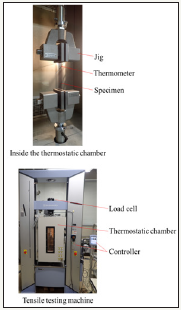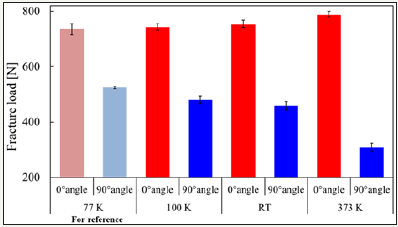- Submissions

Full Text
Research & Development in Material Science
Effect of Temperature on the Tensile Strength of Triaxial Woven CFRP
Kenya Nakajima1, Susumu Kumagai2, Akihito Watanabe3 and Fumio Narita1*
1Department of Materials Processing, Tohoku University, Japan
2Department of Materials and Environmental Engineering, National Institute of Technology-Sendai College, Japan
3Sakase Adtech Co. Ltd, Japan
*Corresponding author: Fumio Narita, Department of Materials Processing, Graduate School of Engineering, Tohoku University, Aoba-yama, 6-6-02, Sendai 980-8579, Japan
Submission: April 18, 2018;Published: April 25, 2018

ISSN: 2576-8840
Volume5 Issue4
Abstract
Triaxial woven carbon fiber reinforced polymers (CFRPs) are an important branch of modern engineering materials, with wide applications in space. This communication gives a short overview of the effect of temperature on the tensile strength of triaxial woven CFRP. Tensile tests were performed on this composite at liquid nitrogen temperature (77 K), 100 K, room temperature and 373 K. Mechanical load was applied along both the axial and transverse directions, and the effects of temperature and loading direction on the fracture load were discussed. This work is the first to demonstrate the tensile property of triaxial woven CFRP from low to high temperatures.
Keywords: Tensile testing; Triaxial woven CFRP; Fracture; Severe environments
Introduction
The use of carbon fiber reinforced polymers (CFRPs) in space applications has been challenging, along with their development and improvement [1]. Because CFRPs can be used in dimensionally critical applications, they must retain mechanical properties during long-term use. Triaxial woven CFRPs have a characteristic of exhibiting rigidity with a small quantity of yarn [2]. They are used as industrial antenna reflector material in Mars and asteroid probes. Recently, mechanical behavior of complex composites such as triaxial and biaxial composites was investigated, since they are used in various applications and enhanced performance. Zhang et al. [3] studied free-edge effect and its impact on the mechanical properties of a single-layer triaxially braided composite. The results indicated that free-edge effect is an inherent factor of the antisymmetric braided architecture of bias fiber bundles. Roy et al. [4] investigated the tensile response of thin-walled composite tubes with multi-axial fibre architecture. They suggested that the hoop layers sandwiched between braid layers will improve structural integrity. Carpintero et al. [5] analysed the translaminar fracture response of triaxial braided composites by means of compact tension tests. Richter et al. [6] proposed a novel simulation framework for accurately predicting the mechanical response of highly compacted triaxial braided composites using meso-scale finite element models. The excellent correlation of the internal geometry and the elastic properties underlined the framework’s potential for future damage modelling. Zhao et al. [7] extended the framework of thermodynamics to micromechanical models by considering the energy stored and dissipated at the inter-particle contacts.
Triaxial woven CFRP is also expected to be used for the Jupiter probe. Because Jupiter is farther from the sun than Mars and asteroids, the temperature is lower. On the contrary, the surface temperature around the Earth is high in areas where the sunlight hits. Therefore, the evaluation of mechanical properties from low to high temperatures is important. The purpose of this work is to evaluate the tensile strength of triaxial woven CFRP from low to high temperatures.
Experimental Procedures
The single-ply triaxial woven CFRP was used for the experiment. Two kinds of specimens with angles of 0° and 90° were prepared. Figure 1(a) shows the 0° angle specimen. The 0° angle specimen was defined as having the axial bundle along the length direction, with width 25 mm, length 160 mm, and thickness 0.14 mm. Figure 1(b) shows the 90° angle specimen with the same dimensions. The 90° angle specimen has the axial bundle perpendicular to the length direction. Tabs made of plain woven glass fiber reinforced polymer (GFRP) “SL-ES30” were bonded to the specimen ends by means of an adhesive system that is suitable for use at low temperatures. The tab has a width of 25 mm, length of 30 mm, and thickness of 2 mm, and the distance between the two tabs is 100 mm.
Figure 1: Specimens for tensile test.

Tensile tests were carried out at 100 K, room temperature and 373 K in thermostatic chamber (Figure 2). These temperature environments were achieved by a PID controller with a liquid nitrogen sprayer and a heater. The tensile testing machine (AG- 100 KNX Shimadzu Co. Ltd., Japan) was operated at a crosshead speed of 0.1 mm/min with a 5 kN load cell. Tensile tests were also performed at liquid nitrogen temperature (77 K). The 77 K testing was conducted with the specimens immersed in liquid nitrogen (not shown here) [8].
Figure 2: Experimental set-up of tensile test.

Results and Discussion
Figure 3: Averages of the fracture loads.

Figure 3 shows the fracture load averages of the triaxial woven CFRP in each test condition. The fracture load of the 90° angle specimen became smaller than that of the 0° angle specimen in all conditions. This is due to the fact that the axial bundle of the 90° angle specimen runs perpendicular to the load direction. It was shown that the fracture load of the 90° angle specimen increases as the temperature decreases. It is assumed that, due to its structure, the resin properties dominate over the fracture. Actually, the strength of resin increases as the temperature decreases. On the other hand, the fracture load of the 0° angle specimen decreased as the temperature decreased. For the 0° angle specimen, carbon fiber may be dominant. In fact, CFRP seems to display a similar tendency [8].
It was demonstrated that the temperature dependence of fracture load is different for the loading direction. In particular, the fracture load of the 0° angle specimen is higher for 373 K and lower for 77 K. On the other hand, for the 90° angle specimen, the lower temperature gave the best scenario for design purpose and the loading direction is by no means negligible.
Conclusion
In this short communication, tensile tests on the triaxial woven CFRP were conducted at liquid nitrogen temperature (77 K), 100 K, room temperature and 373 K. It was shown that the fracture load of the 90° angle specimen becomes smaller than that of the 0° angle specimen in all conditions. The fracture load of the 90° angle specimen increased as the temperature decreased. On the other hand, the fracture load of the 0° angle specimen decreased as the temperature decreased. Important challenges in the coming years are stress analysis, using finite element method, and fracture prediction. Our future studies will be directed to address these concerns.
References
- Kasen MB (1975) Mechanical and thermal properties of filamentaryreinforced composites at cryogenic temperatures. Advanced composites Cryogenics 15(2): 701-722.
- Dano ML, Gendron G, Picard A (2000) Mechanical behavior of a triaxial woven fabric composite. Mech Compo Mater Struct 7: 207-224.
- Zhang C, Binienda WK, Goldberg RK (2015) Free-edge effect on the effective stiffness of single-layer triaxially braided composite. Compos Sci Technol 107: 145-153.
- Roy SS, Potluri P, Soutis C (2017) Tensile response of hoop reinforced multiaxially braided thin wall composite tubes. Appl Compos Mater 24: 397-416.
- Carpintero AG, van den Beuken BNG, Haldar S, Herráez M, González C, et al. (2018) Fracture behaviour of triaxial braided composites and its simulation using a multi-material shell modelling approach. Eng Fract Mech 188: 268-286.
- Richter TW, Carvalho NVD, Pinhoc ST (2018) A meso-scale simulation framework for predicting the mechanical response of triaxial braided composites. Composites A 107: 489-506.
- Zhao CF, Yin ZY, Misra A, Hicher PY (2018) Thermomechanical formulation for micromechanical elasto-plasticity in granular materials. Int J Solids Struct 138: 64-75.
- Kumagai S, Shindo Y, Horiguchi K, Takeda T (2003) Mechanical characterization of CFRP woven laminates between room temperature and 4K. JSME International Journal A 46: 359-364.
© 2018 Fumio Narita. This is an open access article distributed under the terms of the Creative Commons Attribution License , which permits unrestricted use, distribution, and build upon your work non-commercially.
 a Creative Commons Attribution 4.0 International License. Based on a work at www.crimsonpublishers.com.
Best viewed in
a Creative Commons Attribution 4.0 International License. Based on a work at www.crimsonpublishers.com.
Best viewed in 







.jpg)






























 Editorial Board Registrations
Editorial Board Registrations Submit your Article
Submit your Article Refer a Friend
Refer a Friend Advertise With Us
Advertise With Us
.jpg)






.jpg)














.bmp)
.jpg)
.png)
.jpg)










.jpg)






.png)

.png)



.png)






